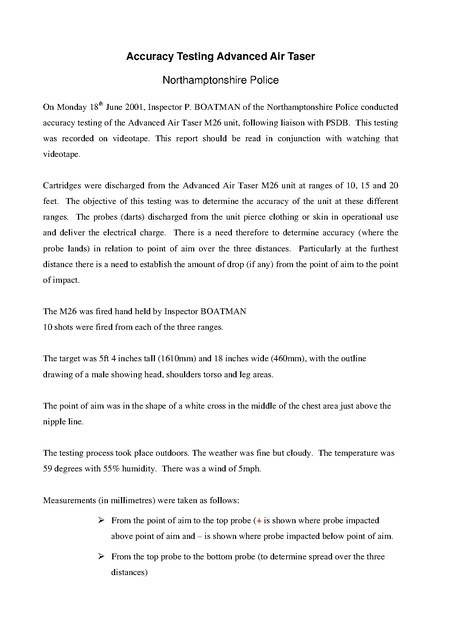Taser M26 Accuracy Testing Northamptonshire 2001
Download original document:

Document text

Document text
This text is machine-read, and may contain errors. Check the original document to verify accuracy.
Accuracy Testing Advanced Air Taser Northamptonshire Police On Monday 18th June 2001, Inspector P. BOATMAN of the Northamptonshire Police conducted accuracy testing of the Advanced Air Taser M26 unit, following liaison with PSDB. This testing was recorded on videotape. This report should be read in conjunction with watching that videotape. Cartridges were discharged from the Advanced Air Taser M26 unit at ranges of 10, 15 and 20 feet. The objective of this testing was to determine the accuracy of the unit at these different ranges. The probes (darts) discharged from the unit pierce clothing or skin in operational use and deliver the electrical charge. There is a need therefore to determine accuracy (where the probe lands) in relation to point of aim over the three distances. Particularly at the furthest distance there is a need to establish the amount of drop (if any) from the point of aim to the point of impact. The M26 was fired hand held by Inspector BOATMAN 10 shots were fired from each of the three ranges. The target was 5ft 4 inches tall (1610mm) and 18 inches wide (460mm), with the outline drawing of a male showing head, shoulders torso and leg areas. The point of aim was in the shape of a white cross in the middle of the chest area just above the nipple line. The testing process took place outdoors. The weather was fine but cloudy. The temperature was 59 degrees with 55% humidity. There was a wind of 5mph. Measurements (in millimetres) were taken as follows: ¾ From the point of aim to the top probe (+ is shown where probe impacted above point of aim and – is shown where probe impacted below point of aim. ¾ From the top probe to the bottom probe (to determine spread over the three distances) The measurements over the two distances are shown in the table below. TABLE SHOWING DISTANCE IN MILLIMETRES FROM POINT OF AIM TO POINT OF IMPACT – TOP PROBE & Spread between the two probes Shot Numbers 1 2 3 4 5 6 7 8 9 10 Using Duracell Ultra Batteries Distance in Millimetres 10 ft Range Top probe Spread -10 +75 0 +20 +20 0 +30 -10 -15 0 360 425 340 400 380 400 445 355 420 395 15ft Range Top Probe Spread -100 -75 -175 +15 +10 -90 -80 0 -55 -25 575 425 540 560 540 565 530 625 685 520 20 ft Range Top Probe Spread -65 -145 -70 0 -110 -140 -175 -220 -125 -200 860 745 735 680 745 755 615 660 805 655 Of the 30 shots fired, no probes landed in the head area of the target Of the 30 shots fired no probes (top or bottom) missed the target area, even with the largest drop of 220 mm the top probe landed in the midsection area. Comments: At the 10 ft range there were three bulls eyes – the top probe impacted at point of aim. 4 probes landed above the point of aim at distances of between 15 to 30mm. 3 probes impacted below the point of aim –ranging from 10mm to 15 mm. At the 15 ft. range there was one bulls eye – the top probe impacted at point of aim. 2 probes landed above the point of aim at 10 and 15mm. 7 probes impacted below the point of aim, ranging from 25 to 175mm (about 7 inches) At the 20 ft range there was one bulls eye – the probe impacting on point of aim. No probes impacted above the point of aim. 9 probes impacted below the point of aim, ranging from 65mm to 220mm (about 8½ inches)

